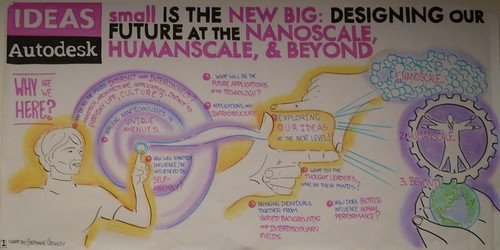Last week I joined a fantastic group of scientists, designers, architects and engineers at an Autodesk IDEAS event on the theme of “Small is the New Big: Designing Our Future at the Nanoscale, Humanscale, and Beyond“. Why should I be interested in the Nanoscale and Synthetic Biology? Their welcoming note summarizes it nicely:
“Imagine it is the mid 1970’s and you were thinking about the potential opportunities for a programmable personal computer. It would be hard to imagine the exponential growth of computation, connectivity, and miniaturization that powers a globally connected network of technologies that today define, transform, and create industries. Today, advancements in programming matter at the nanoscale, and synthetic biology in particular promise imminent disruption to industries beyond just the medical and pharmaceuticals.”
My main takeaways from the discussions are below.
DNA ‘strand sequencing’ – price drop a million fold in 10 years.
Oxford Nanopore has created the MinION USB device for portable analysis of single molecules for under $1000 with a 4% error rate. This is a huge step forward from the millions invested to sequence the human genome 10 years ago. It is not inconceivable that by 2018 the device cost for sampling DNA will mean that it will become an on demand service for a few dollars. This may also mean an increasing trend towards understanding authenticity – 30% of fish mis labeled in NYC restaurant – shown by DNA testing.
The end of blockbuster drugs?
Big Pharma has transitioned from an R&D based enterprise to a marketing based enterprise. The number of drugs delivered per billion dollar investment has dropped one hundred fold over the last few decades. Reasons cited include the risk aversion of companies (due to threat of compensation) and regulation of the public office (most drugs have potential side affects for someone). As a result there are increasing concerns that not taking action on bringing drugs to market is costing lives. A formula for risk / reward / regulation is needed but seems to be unobtainable. An interesting middle ground is being established where smaller companies are creating drugs targeted at individuals which then bypass the need to run large scale double blind trials. See also Rare Genomics Institute.
Building a nano robot using DNA origami – awesome!
Why build at nanoscale? The need to work at the scale we are investigating. Great demo of how Cadnano, a generalized platform for 3D construction, was used to build a nano robot to mimic immune system and target cancer cells. The video below is worth 6 minutes of your life for both the technical wizardry and potential of the science.
Other insights:
Gary Wolfe on “when this knowledge arrives, where will it be stored, in what knowledge system, the doctors office?”
Omri Amirav-Drory on his companies “Genome Compiler”, an IDE for creating genes to send to gene synthesis shops.
Daisy Ginsberg on “how does the reflective component, beyond the aesthetic, change the work of the synthetic biologists?” great projects at http://www.daisyginsberg.com/
Skylar Tibbits on his Self-Assembly and Computational Construction demo built for TED 2012 using magnetic structures. Really cool.
Final notes:
This area is moving so fast, people don’t think of this stuff as computers. DNA as software is a radical thought to many. Viruses as apps is the next big thing, but may need careful branding for uptake beyond the scientific community (ie be careful about “killer apps”).
Themes of discussions during the cage fights:
- Regulation vs free market
- Old ideas being rebranded vs new discipline
- Abundance vs destruction
4 themes from the second day discussions:
Big urgent idea.
Data sets increasing in size. Big data mining. Crowd source / mechanical Turks to mine the data. Opt in data. Privacy controls. Subscribing to the global immune system.
Framework for design.
Tools to help the layman design with synbio. Inspired by nanocad and building of nano robots. Making synthetic bio plastics, designing and growing bio facades.
Security.
Nightmare scenarios, bioterrorism, pathogens available, read and write functions available. Accidental exposure. License to create organism. Net nanny for bio. Asimov laws of synbio. Private islands off shore hosting synbio “culturally” unacceptable elsewhere.
A manifesto for SynBio
Industrial model has caused its own obsolescence – wasteful, toxic, unsustainable….
- Autotrophic energy sources
- Open source
- Distributed
- Self contained production
- useful waste / biodegradable – Lifecycles and not life spans – Disposal included in design – Self optimizing – context adaptive
- Ethical and responsible – ecologically inclusive
- Symbiotic and convergent with existing methods and platforms
- Ecosystems and diversity not mono cultures
- Inclusive design – species / audience / cultures
- Direct value representation
- Consuming is useful
- Personalized
Some photos are on Flickr, links to tweets on twitter and notes to links are on Pinboard
